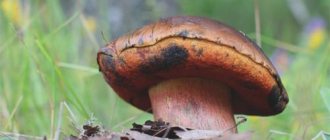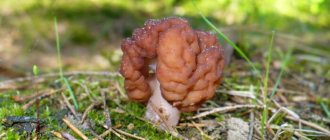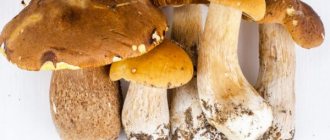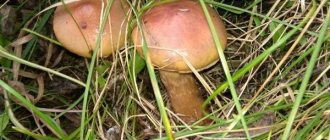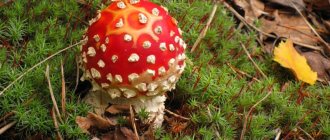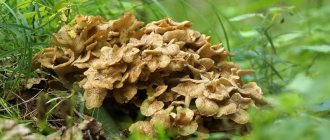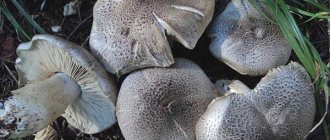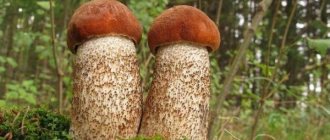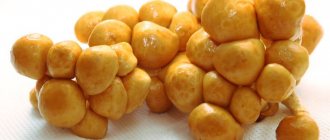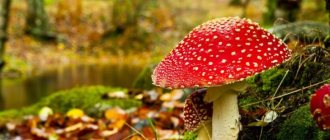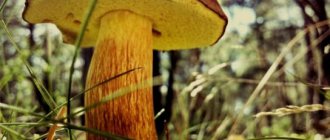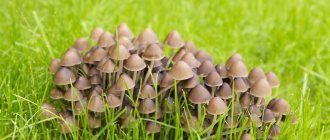Some mushrooms also have to be included in the Red Book; the blue mushroom Gyroporus, or bruise, is one of them. It grows almost throughout the CIS. But it is becoming less and less common due to the deteriorating environmental situation. For this reason, it is considered to be listed in the Red Book not only in Russia. but also throughout the territory of the countries of the former Union.
It is no coincidence that the mushroom received its original popular name - at the slightest touch, its cap and flesh begin to characteristically turn blue. For this reason, some inexperienced mushroom pickers, having cut a mushroom and mistaking it for boletus, believe that they are dealing with almost a poisonous natural phenomenon, and throw it away without regret.
Meanwhile, the mushroom has excellent taste and is considered unconditionally edible.
True, environmentalists advise that if you encounter this rarity in the forest, it is better to leave it where it grows. Still, there are fewer and fewer of these mushrooms left every year, and they grow singly or in small colonies.
general characteristics
Gyroporus blue is a tubular mushroom of the Boletaceae family. It is a close relative of boletus mushrooms, slightly reminiscent of porcini mushroom and boletus mushroom. But it has a distinctive feature - when mechanically damaged, the flesh turns blue in a few seconds. Therefore, this mushroom is often called a bruise.
This name accurately conveys its behavior: with any touch, blue spots appear on the surface. The pulp changes color very quickly, the color of the spots is intense, bright blue. This distinguishes the bruise mushroom from other representatives of Boletaceae.
The blue discoloration of the flesh is due to the presence of the substance boletol. This is a natural antibiotic that was discovered in the mid-20th century. Because of this, the bruises were almost eradicated. Now blue gyroporuses are listed in the Red Book and are classified as rare mushrooms.
It differs from other representatives of Boletovs in the following characteristic features:
- with mechanical damage, the pulp quickly and strongly changes color, becoming bright blue;
- the leg becomes hollow inside with age;
- the upper surface of the cap and the lower part of the stem have the same shade;
- spores are small, yellowish;
- The pulp is brittle, with a slight mushroom smell and a pleasant nutty taste.
Etymology of the bruise mushroom
The generic name "Gyroporus" comes from the Greek "Gyros" meaning "round" and "porus" meaning "hole", hence the round pores; while the specific epithet "cyanescens" means "turning blue".
Like other boletes, Gyroporus cyanescens is an ectomycorrhizal fungus, meaning it forms a symbiotic relationship with the root system of trees. In the case of bruise fungus, it has been found to be associated with a variety of coniferous trees, including pine and spruce, as well as some hardwoods such as birch and oak.
Because blackleaf is a type of mycorrhizal fungus, it depends on living host trees for population viability. This mutually beneficial symbiotic association between the fungus and the roots of the host plant carries numerous critical benefits for the survival of the host plant. Mycorrhizal fungi such as bruise are essentially multi-nutrient absorption organs, i.e. nitrogen, phosphorus, numerous trace elements, i.e. boron, selenium, copper and play an important role in water absorption. Both the fungus and the host plant do not exist in nature without each other.
Bruises are known for their nutritional value as they are a good source of antioxidants, selenium, vitamins such as vitamin B, and fiber.
Description of appearance
Gyroporus blue belongs to the tubular mushrooms. In appearance it resembles many other varieties. But there are several signs by which you can determine that it is a bruise.
- The cap is convex at first, but becomes flat with age. Reaches 15 cm in diameter, on average 4-8 cm. The surface is rough, velvety, dry to the touch, covered with hairs. The color on top is yellowish-brown or light brown, can be white, and darkens when pressed.
- The lower surface of the cap is tubular, white or yellowish. Turns blue quickly when touched. The pores are small, round, the tubes are deep, the spore powder is light yellow.
- The leg is not thick, even, up to 3 cm in diameter. Sometimes there is a slight thickening in the middle, narrowing downwards. Reaches a length of 12 cm, the pulp is cottony, with age it becomes dense, but loose, with voids. Visually it is divided into two parts: under the cap it is smooth and white, below it is pubescent, matching the color of the cap.
- The pulp is white, creamy or slightly yellowish, dense and fragile. It breaks easily and turns blue quickly when cut. This rich cornflower blue color remains unchanged.
Gyroporus chestnut
Another representative of the Gyroporus family. Belongs to the department Basidiomycetes, forged Agaricomycetes. Genus: Gyroporus.
hat
The cap of this mushroom has a characteristic rusty tint with brown spots. Less often it is red-brown. Even rarer is the chestnut shade. The younger the mushroom, the lighter its cap, but with age it becomes darker. The diameter of the mushroom reaches 11 cm. The surface of this mushroom, if you run your hand over it, is quite velvety. Also a little fluffy. Less often it is bare and without a single lint. If the sun's rays hit the mushroom cap directly, it begins to crack. If you look under the cap, the tubes inside are first white, then acquire a yellow tint. As for older age, the cap becomes less elastic and drier.
Pulp
Special attention is paid to the pulp. It is quite white, and at the same time it tries not to change its color when cut. At first it is quite hard, but meaty. However, with age it becomes more fragile. At the same time, its smell and taste are quite unpleasant, so many people prefer to avoid chestnut gyroporus.
By the way, the spore powder of this mushroom has a pale yellow tint.
Leg
The leg is quite stable. It is unevenly cylindrical, but at the same time it can bend at any angle. Club-shaped and rather flattened. Dry, reaches a height of up to 30 mm. Same thickness. The inside of the leg is quite elastic, but with age this elasticity is proportionately lost. Often the cap outweighs the stem and breaks off.
Where to grow and when to go
If you're looking to find the Chestnut Gyroporus, you're in luck. This mushroom is especially widespread in the central territory of Russia. It grows in a large brood at once, so if you spot it in a clearing, know that there are probably many of its brothers around.
This mushroom grows from July until November, provided that the autumn is warm. If it is cold, then you need to go for mushrooms in late September early October.
For growth it prefers coniferous and at the same time deciduous forests. Also, it mainly prefers sandy soils, preferably moist soils. Loves dry soils, settles away from swamps.
The fruiting bodies are somewhat spread out from each other, however, they are still grouped well. In one clearing you can find up to thirty mushrooms at the same time.
Edibility Gyroporus chestnut
Many people say that chestnut gyroporus is much worse in taste, in contrast to blue gyroporus. This is true. Despite the fact that this mushroom is edible, it still has a very specific taste.
First, you feel the aroma of champignons, and then it acquires a bitterish tint. Even after heat treatment, this mushroom cannot be eaten. At some point it becomes so bitter that there is nothing left to do but throw it away. Also, it can permeate absolutely all the ingredients that were prepared with it with bitterness. For example, if gyroporus is mistakenly baked with potatoes, the potatoes also become very bitter.
Therefore, this mushroom is best used as a seasoning. Indeed, a slight bitterness will not be a problem for some people, and in general, this mushroom perfectly replaces pepper and becomes more aromatic.
To prepare the seasoning, you need to perform the following steps.
Important! Gyroporus chestnut mushroom is quite toxic. If he grew up near roadways, enterprises, or production facilities, then he should not be taken in this way.
To begin with, the mushroom is washed well under running water.
Remove all trash. The mushroom is well dried and cut into several parts. Then boil for about 10 minutes in boiling water. The mushroom is salted again, and then it is carefully placed on baking paper on a baking sheet. The oven temperature is set to 60-70 degrees. The mushrooms are sent there for one and a half to two hours.
However, check the readiness periodically. To do this, you need to take a piece of mushroom in your hands and try to break it. As soon as this happens with a crunch, it means the drying mode is over. Now you need to let the mushrooms cool at room temperature. However, try not to make it humid. Once the mushroom has cooled, we suggest grinding it in a coffee grinder. Ready, tasty and bitter seasoning will decorate any of your dishes.
However, it is recommended to store it in a dry jar in a dark place.
Similar varieties
Blue discoloration occurs due to the reaction of certain substances from the mushroom pulp with oxygen. In some fruits, only the stem turns blue, others quickly change color to black or brown. All blue mushrooms belong to the Boletaceae family. But only in Gyroporus the flesh acquires a rich cornflower blue color and no longer changes it. Therefore, when picking mushrooms, you need to look into the basket after 20 minutes. If the fruit remains blue when cut, this is an edible bruise.
Most of all it is similar to another gyroporus - chestnut. They are identical in appearance, but it is easy to distinguish them. Chestnut does not turn blue, and when cooked it is slightly bitter. Gyroporus also resembles several types of edible and conditionally edible mushrooms, the flesh of which can also turn blue.
- Yunkvil's boletus can easily be confused with a bruise. Its flesh turns blue when cut, and its appearance is also similar. But after a few minutes the color changes to black.
- The dunhead or black boletus changes color only on the stem, and not always. His hat is semicircular, convex, almost black. It grows only near birch trees on the roots, in the grass.
- In boletus, the flesh first turns blue, then turns black. It is distinguished by an orange-red cap and a high stem. Grows in mixed and deciduous forests.
- Podbovik or speckled oakberry is a conditionally edible mushroom. Found in mixed forests. The flesh turns blue, but then changes color again - it becomes lighter on the cap and turns brown on the stem.
- An oiler with an oily cap may also turn blue. But the color changes very slowly, slightly and not always.
- The olive-brown oakberry turns blue when cut, but then turns brown. It can be distinguished by the characteristic reddish mesh pattern on the stem and the yellowish color of the flesh. This is a conditionally edible mushroom.
Of the inedible or poisonous varieties, the bruise can be confused with two species: the satanic mushroom and the Kele oak mushroom. In Satanic flesh, the flesh may turn slightly blue, but most often turns red. Kele oak is distinguished by yellowish flesh that does not change color. There is not a single poisonous representative of the mushroom kingdom that immediately turns blue even with a slight touch. Therefore, if this happens, you can take these fruits without fear of getting poisoned.
Preparation
- Cut the mushrooms into cubes and the onions into strips. Cut the potatoes into small cubes.
- Wash dried fruits and pour boiling water for 10 minutes. We cut the prunes.
- Fry the onion in vegetable oil and add flour. Let's pass.
- Bring the mushroom broth to a boil and add dried fruits and potatoes. Cook over reduced heat for another 15 minutes.
- Add mushrooms and onions with wheat flour. Stir and cook for a few more minutes.
- Cover with a lid and remove from the stove. Let it brew for 15 minutes.
- Serve in portions, with chopped fresh herbs and sour cream.
Where does it grow
The blue mushroom grows in deciduous and mixed forests. Prefers birch trees, forming mycorrhiza with their roots. That’s why it’s also called birch gyropor. It can bear fruit near oak, chestnut, and in coniferous forests. You can meet him in the meadow, away from the trees. Widely distributed throughout the middle zone, Europe and North America. In Russia, the bruise can be found in birch groves and along roads. It is not found in the southern regions, as it does not tolerate hot climates.
Gyroporuses bear fruit from early July to September. In warm autumn - until mid-October. They usually appear on the north side of the tree, under the leaves, as they do not like bright sun. They grow singly or in small groups, but away from each other. They like sandy, moist and acidic soil.
Bruise is a rare species; in some regions its collection is prohibited. If you want to enjoy an exotic dish, you can take several fruits. Just be sure to cut 1-2 cm from the root with a sharp knife. Do not pull it out of the ground, as this damages the mycelium.
Preparation
We use semi-finished boiled mushrooms and the broth from them - the second cooking. Chop the cabbage finely and throw it into a frying pan in heated vegetable oil. Pour in half a glass of mushroom broth. Simmer over low heat for 20 minutes. Lightly fry the mushrooms and onions separately, and add tomato paste at the end. We bring everything until half cooked and put it in a deep frying pan in layers (the layer of mushrooms should be between the layers of cabbage, which will be at the top and bottom). Pour in the beaten egg and bake in the oven at 180 degrees until golden brown. For the vegetarian option, we don’t use an egg, but simply bake it.
By the way, you can add a little more grated hard cheese to this recipe (sprinkle it over the entire structure before putting it in the oven). This will enrich the taste of the dish and make it more satisfying.
Beneficial features
Bruise has long been valued among people not only for its pleasant aroma and good taste. Even in ancient times, it was used in folk medicine for various diseases. Only in the 20th century did scientists determine the reason for the medicinal properties of gyroporus: the substance boletol was discovered in its composition. This is an effective natural antibiotic with minimal side effects. Used in the treatment of fungal and bacterial infections.
The pulp also contains vitamins, minerals, antioxidants, and fiber. It contains a lot of selenium, choline, vitamin D, phosphorus, potassium, and copper. It was found that a bruise can prevent the development of tumors, obesity and diabetes, improve blood circulation, and strengthen the walls of blood vessels. It has anti-inflammatory and antioxidant effects, lowers cholesterol levels.
Gyroporus stimulates the immune system, helps to recover from serious illnesses, and can be used for tuberculosis, bronchial asthma, and cardiovascular pathologies. This is a dietary product, suitable for weight loss and vegetarian nutrition. Contains plant protein, some carbohydrates and only 19 calories.
Gyroporus sandy
Gyroporus sandy is another representative of the species. Despite its name, it does not like sand, but grows in dark forests. Belongs to the department Basidiomycetes, subdivision Agaricomycetes. Order boletovye, mouth gyroporus.
This mushroom has a very specific appearance, so many mushroom pickers avoid it. Also, it is by no means common in Russia, so for many it is an innovation.
This fungus settles randomly, and where you saw a large cluster a year ago, today they may not be there. Find out more about this forest dweller.
hat
The first thing that catches your eye when you come across sandy gyroporus in the forest is the cap. When young, it has the color of fresh pink salmon.
However, the older the mushroom becomes, the more brown shades appear. The color first changes to yellow, then to dark brown. However, pink spots still remain on the cap. The edges of the mushroom are usually lighter, and sometimes even acquire a white undertone. The diameter of the cap reaches a maximum of 15 cm, and a minimum height of 4 cm.
Its shape is specific; it could be called hemispherical if it were even. However, the depression is present not only in the center, but also at the edges.
If you run your hand over the cap of the gyroporus, you will find that it is quite matte, and sometimes there is a corresponding lint on it.
The hat is very repulsive because most often it is covered with cracks from direct sunlight. Various insects like to settle there, so mushroom pickers avoid sandy gyroporus.
Pulp
The pulp has a white tint. Quite elastic. When interacting with oxygen, it does not change color at all. As for the pores, they are monochromatic.
The softness is fibrous, but with age the mushroom becomes as if empty. It gently loses its moisture and turns into a kind of sponge.
Leg
As for the leg, it has a white tint. However, this only applies to young mushrooms. With age, it acquires a grayer tint, then turns brown.
Over time, the mushroom generally becomes very dark. At a young age, the leg is elastic, reaches a height of up to 10 cm. However, with age, it begins to become crooked, and then completely, it can break under the weight of the cap.
By the way, with age, the leg also acquires a spongy structure.
Where to grow and when to go
Many people dream of finding sandy gyroporus, if only because this mushroom is widely used in folk medicine. But where and when should you look for this mushroom? It is believed that Gyroporus became most widespread in coniferous forests. Loves to grow especially where sandy soils predominate. However, this does not mean that the mushroom prefers dry conditions. As a rule, he likes the absence of moisture, but at the same time, he really likes precipitation and rain. Loves calcareous soils.
This mushroom is an autumn mushroom, so it is recommended to collect it from late summer to early autumn. Provided that the autumn was warm, the mushroom can also be collected from late October to early November.
Places of distribution are CIS countries, including the central part of Russia, Belarus and Ukraine. Sometimes found in the Baltic states in Europe. There's even one in Canada. The mushroom can be called cosmopolitan.
Edibility Gyroporus sandy
Despite the fact that gyroporus has a very unattractive appearance, you should never eat it . However, for some reason many mushroom pickers forget about this. People get seriously poisoned because somewhere, somewhere, they heard that gyroporus is suitable for food. However, this was said about the two previous subspecies, which are absolutely safe for human health. As for Sandy Gyroporus, everything is not so simple.
In fact, this mushroom is quite toxic. Why is this happening?
The mushroom is highly absorbent of harmful substances. Even though young individuals of Gyroporus are recorded as absolutely harmless, with age they absorb a huge amount of toxins from the air and soil. People who are going to eat mushrooms growing along highways, near enterprises or polluted water bodies may be especially seriously affected.
What symptoms can this dangerous forest dweller cause?
As a rule, these are gastrointestinal diseases, poisoning, battles, exacerbations of existing diseases.
Women who are pregnant or breastfeeding especially need to take care of themselves. Also, people who have diseases of the gastrointestinal tract should approach this mushroom with caution. Under no circumstances should children be allowed to try this mushroom.
Sand gyroporus can also cause a hallucinogenic effect, so many people dream of finding it in order to experiment with their health. Of course, this should never be done.
However, Gyroporus sandis is widely used in medicine. An extract is extracted from it, which is then used in the treatment of oncology, as well as to restore the body’s general immunity. It has been proven that the extract of this mushroom can restore potency.
How to eat
Gyroporus blue is mushroom . It has a pleasant mushroom aroma and a nutty taste. Used boiled, fried, dried and pickled. Many lovers consider it no worse than porcini mushroom in terms of taste. But some inexperienced mushroom pickers throw away the cut fruits, afraid of the blue color.
It is recommended to consume bruises after preliminary boiling. There should be 3 times more water than fruit. Cook for 15-20 minutes, then strain. Boil again for 10-15 minutes. On this basis you can prepare soups, side dishes, sauces, caviar and pates. Sour cream, garlic, onions, potatoes, and chicken go well with gyroporus.
The pulp does not taste bitter, remains soft, does not spread and smells pleasant. The peculiarity of bruises is that they cannot be stored for a long time. Even in the refrigerator, they last no more than 2-3 days; it is advisable to process them immediately after collection.
Despite the beneficial properties of blue gyroporus, it is difficult to digest. Therefore, it is not recommended to use it in the following cases:
- children under 7 years old;
- people with kidney or liver diseases;
- for peptic ulcers, gastritis, pancreatitis;
- pregnant and lactating women.
You cannot collect gyroporuses in landfills, former enterprises, near roads and in suburban areas. Gyroporuses quickly absorb toxins and heavy metals from the soil and air and accumulate them in the pulp. In this case, you can even be poisoned by an edible mushroom. It is also not recommended to eat old, wormy or damaged fruits.
Edibility
Gyroporus birch.
Although picking these mushrooms is not recommended (and in some regions not allowed) due to their rarity, it is convenient and easy to prepare. It is good both simply boiled and when fried; housewives often prepare it pickled and dried.
It is noteworthy that it is from gyroporus that excellent quality sauces and juliennes are obtained.
How to grow
Hyroporus blue is often grown for pharmaceutical purposes to produce an antibiotic. You can try growing it in your garden. The main conditions for normal growth are warmth, high humidity and shade. You need to choose a suitable place on the site, preferably near a birch, chestnut or oak tree. Collect mycelium along with soil in the forest. To plant mycelium, follow the step-by-step instructions.
- Mix the mycelium with dry soil, add sand, birch leaves and twigs.
- At the selected location, make a trench 15 cm deep.
- Place the mycelium, distributing it evenly.
- Sprinkle with fertile soil.
- Water from a watering can, pouring 10 liters per square meter.
- Sprinkle again with a layer of soil and leaves.
- Constantly maintain high humidity.
Bruise is an amazing mushroom that can turn blue when pressed. It is very rare and is even listed in the Red Book. Once you find it, you should not throw it away, as it is not only tasty, but also healthy. To diversify your diet, you can grow it on your own plot.
Distribution and when to collect
Hyroporus blue is very rare. It can be found in the northern temperate zone of Russia in mixed or deciduous forest. It prefers a humid climate. It forms mycorrhizae most often with birch, oak or chestnut trees, and lives on sandy soils. The first mushrooms can be found already in mid-summer; the fruiting season for bruises lasts until October.
Answers to common questions
Due to its rarity and obscurity, blue gyroporus raises many questions among inexperienced mushroom pickers:
Tasty, aromatic and healthy bruises with blue flesh are rare, but found in European forests. By carefully collecting them or breeding them yourself, you can diversify your diet and enrich your body with useful substances.
Blue gyroporus, commonly known as the bruise mushroom, belongs to the tubular family. There is another name for an unusual representative of the mushroom kingdom - birch gyropore.
Mushroom bruise - description and beneficial properties
Literature
- Mushrooms of the USSR
- M.: Mysl, 1980. - Dermek A. Mushrooms
. - Bratislava: Slovart Publishing House, 1989, pp. 143-144. - Mushrooms: Directory / Transl. from Italian F. Dvin. - M.: “Astrel”, “AST”, 2001. - P. 218. - 304 p. — ISBN 5-17-009961-4.
- Lesso T.
Mushrooms, key / trans. from English L. V. Garibova, S. N. Lekomtseva. - M.: “Astrel”, “AST”, 2003. - P. 195. - ISBN 5-17-020333-0. - Serzhanina G.I.
Hat mushrooms of Belarus. - Minsk: Science and Technology, 1984.
